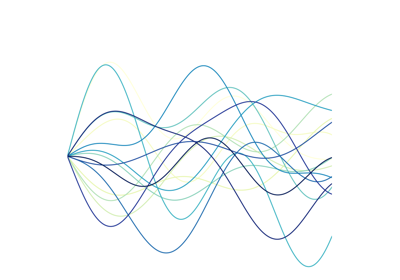tslearn.preprocessing.TimeSeriesScalerMinMax¶
- class tslearn.preprocessing.TimeSeriesScalerMinMax(value_range=(0.0, 1.0))[source]¶
Scaler for time series. Scales time series so that their span in each dimension is between
minandmaxwherevalue_range=(min, max).- Parameters:
- value_rangetuple (default: (0., 1.))
The minimum and maximum value for the output time series.
Notes
This method requires a dataset of equal-sized time series.
NaNs within a time series are ignored when calculating min and max.
Examples
>>> TimeSeriesScalerMinMax(value_range=(1., 2.)).fit_transform([[0, 3, 6]]) array([[[1. ], [1.5], [2. ]]]) >>> TimeSeriesScalerMinMax(value_range=(1., 2.)).fit_transform( ... [[numpy.nan, 3, 6]] ... ) array([[[nan], [ 1.], [ 2.]]])
Methods
fit(X[, y])A dummy method such that it complies to the sklearn requirements.
fit_transform(X[, y])Fit to data, then transform it.
Get metadata routing of this object.
get_params([deep])Get parameters for this estimator.
set_output(*[, transform])Set output container.
set_params(**params)Set the parameters of this estimator.
transform(X[, y])Will normalize (min-max) each of the timeseries.
- fit(X, y=None, **kwargs)[source]¶
A dummy method such that it complies to the sklearn requirements. Since this method is completely stateless, it just returns itself.
- Parameters:
- X
Ignored
- Returns:
- self
- fit_transform(X, y=None, **kwargs)[source]¶
Fit to data, then transform it.
- Parameters:
- Xarray-like of shape (n_ts, sz, d)
Time series dataset to be rescaled.
- Returns:
- numpy.ndarray
Resampled time series dataset.
- get_metadata_routing()[source]¶
Get metadata routing of this object.
Please check User Guide on how the routing mechanism works.
- Returns:
- routingMetadataRequest
A
MetadataRequestencapsulating routing information.
- get_params(deep=True)[source]¶
Get parameters for this estimator.
- Parameters:
- deepbool, default=True
If True, will return the parameters for this estimator and contained subobjects that are estimators.
- Returns:
- paramsdict
Parameter names mapped to their values.
- set_output(*, transform=None)[source]¶
Set output container.
See Introducing the set_output API for an example on how to use the API.
- Parameters:
- transform{“default”, “pandas”}, default=None
Configure output of transform and fit_transform.
“default”: Default output format of a transformer
“pandas”: DataFrame output
None: Transform configuration is unchanged
- Returns:
- selfestimator instance
Estimator instance.
- set_params(**params)[source]¶
Set the parameters of this estimator.
The method works on simple estimators as well as on nested objects (such as
Pipeline). The latter have parameters of the form<component>__<parameter>so that it’s possible to update each component of a nested object.- Parameters:
- **paramsdict
Estimator parameters.
- Returns:
- selfestimator instance
Estimator instance.
- transform(X, y=None, **kwargs)[source]¶
Will normalize (min-max) each of the timeseries. IMPORTANT: this transformation is completely stateless, and is applied to each of the timeseries individually.
- Parameters:
- Xarray-like of shape (n_ts, sz, d)
Time series dataset to be rescaled.
- Returns:
- numpy.ndarray
Rescaled time series dataset.
Examples using tslearn.preprocessing.TimeSeriesScalerMinMax¶
Hyper-parameter tuning of a Pipeline with KNeighborsTimeSeriesClassifier
Learning Shapelets: decision boundaries in 2D distance space
